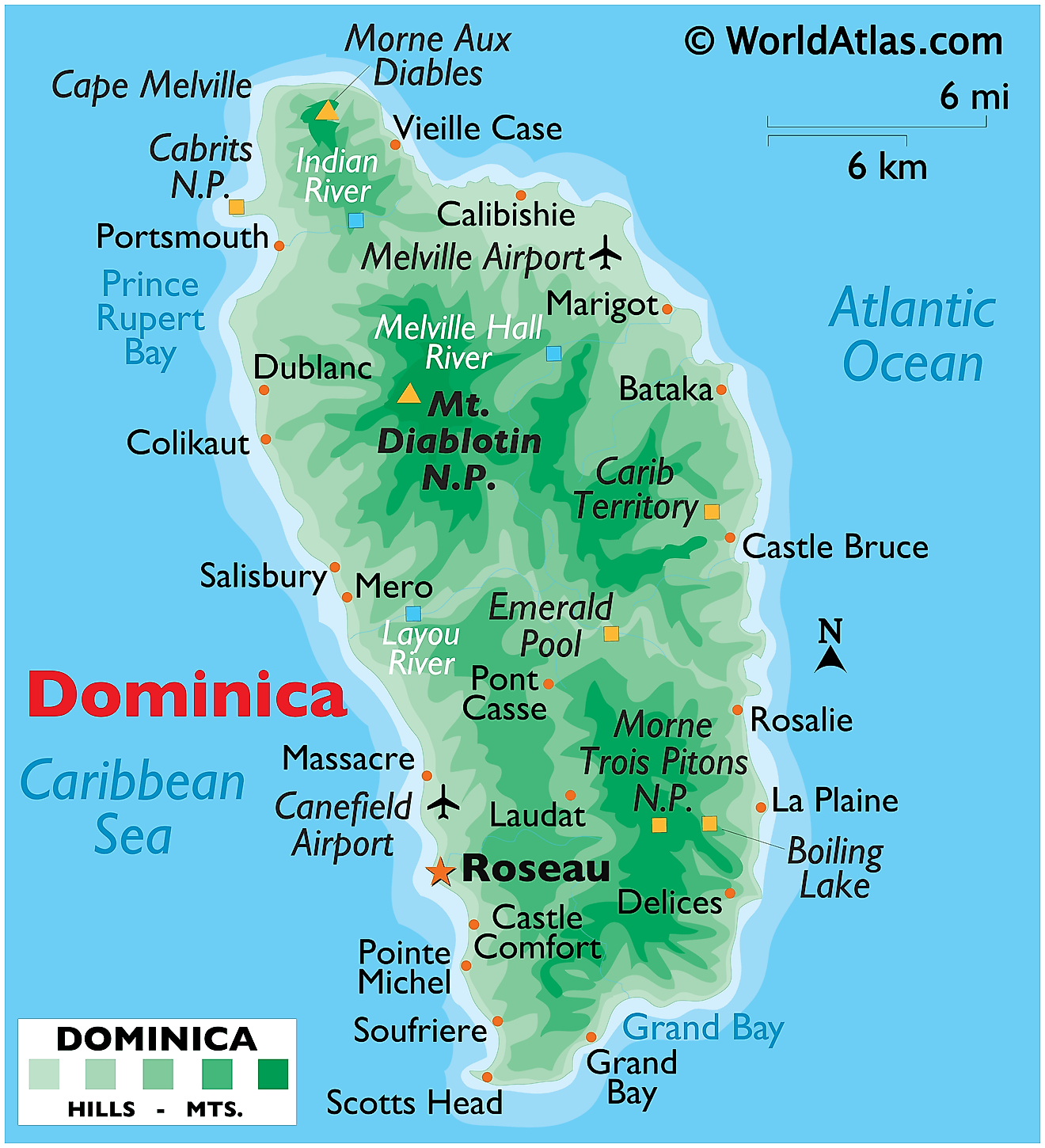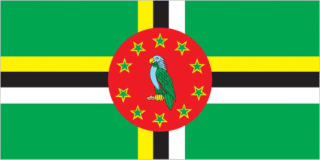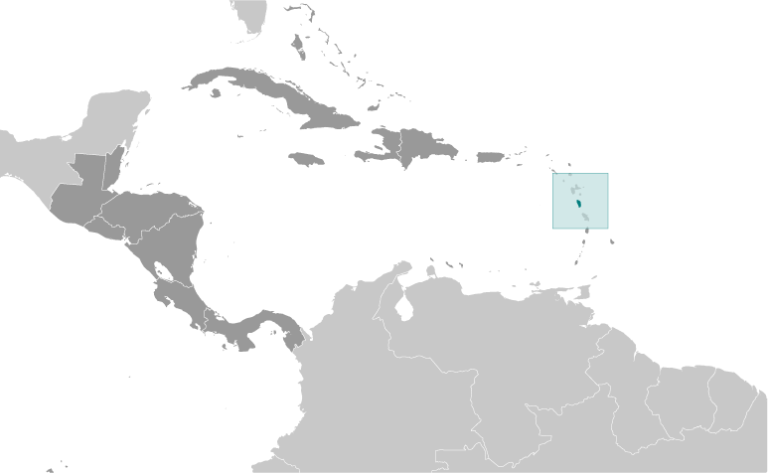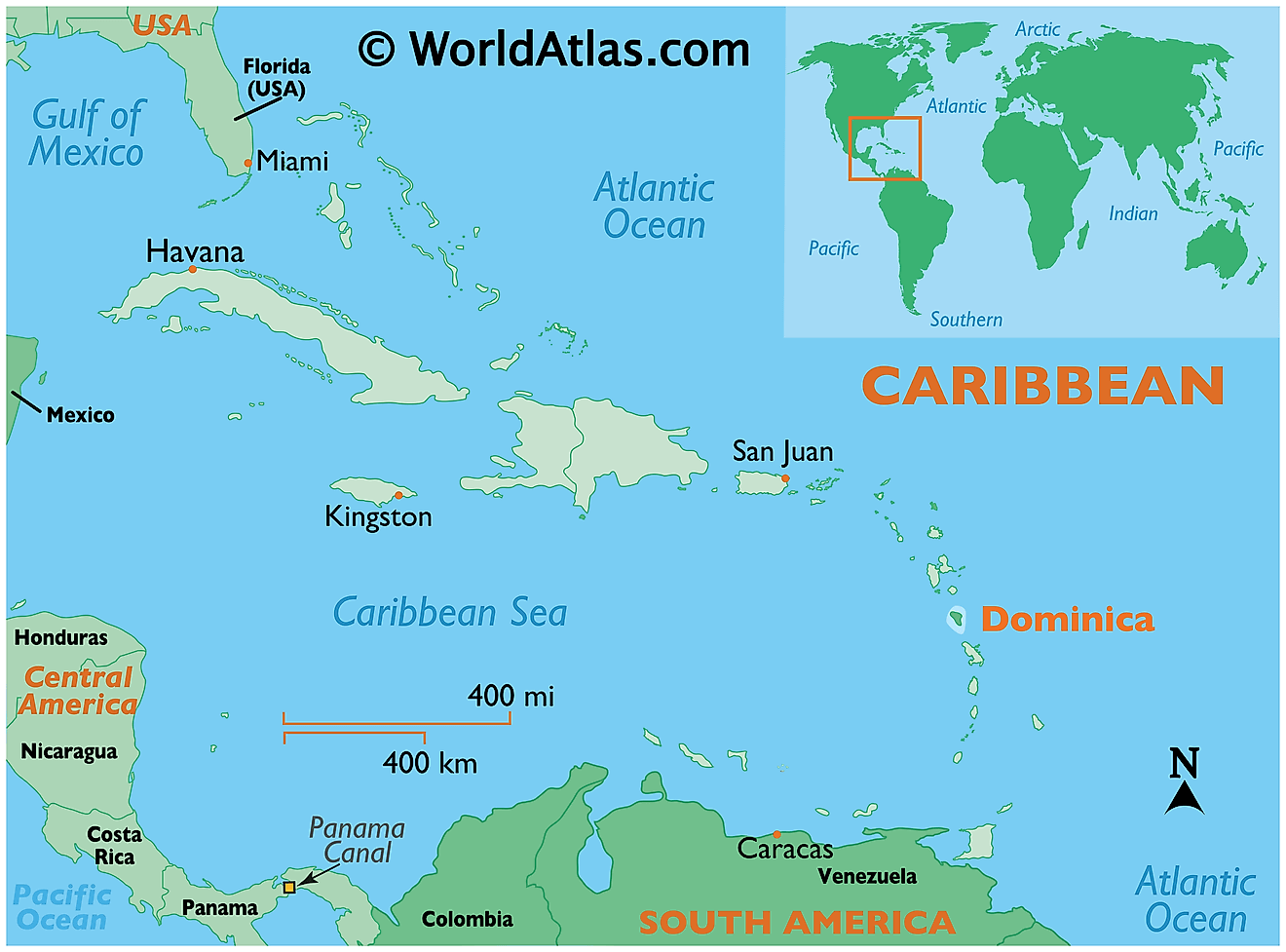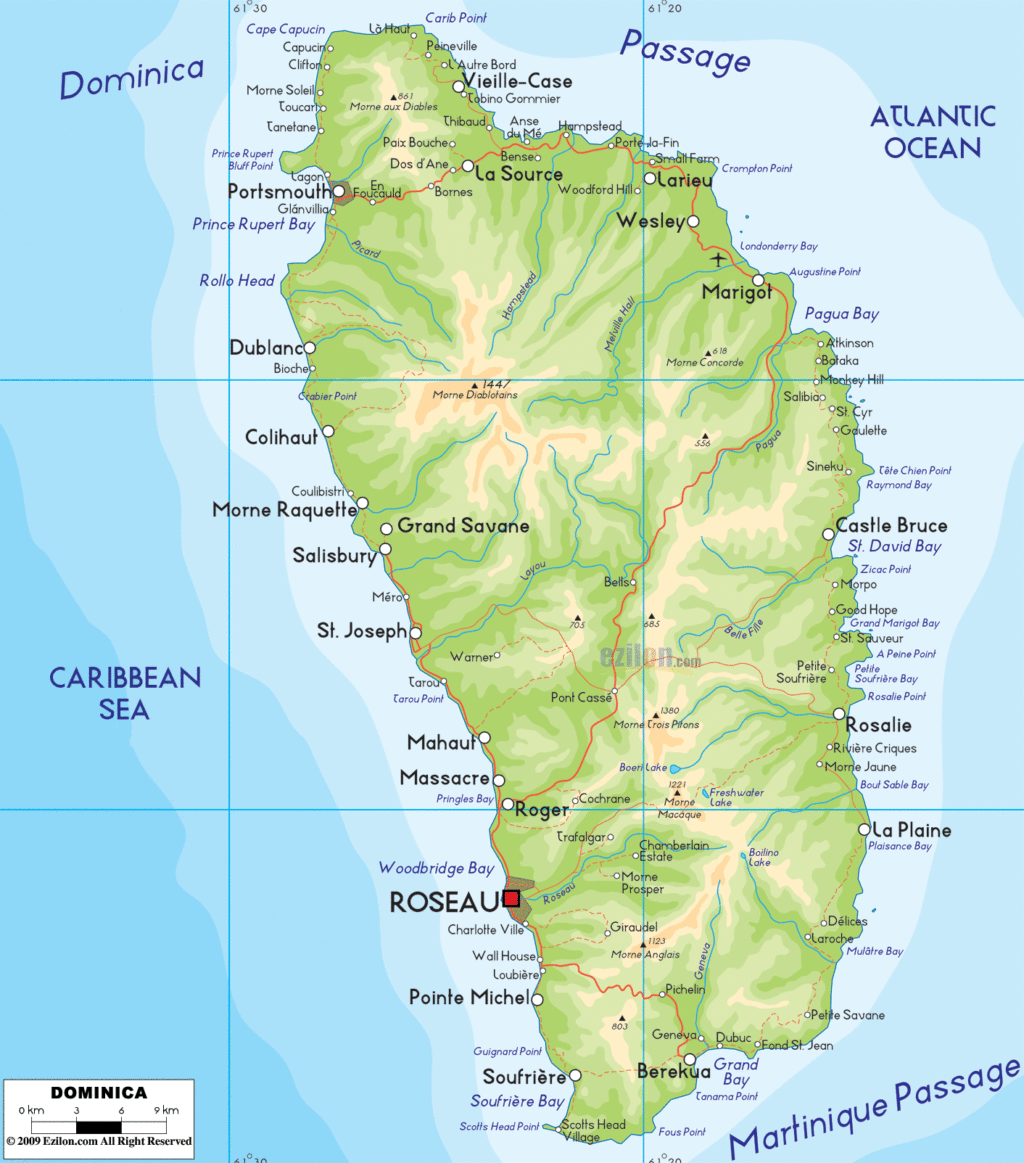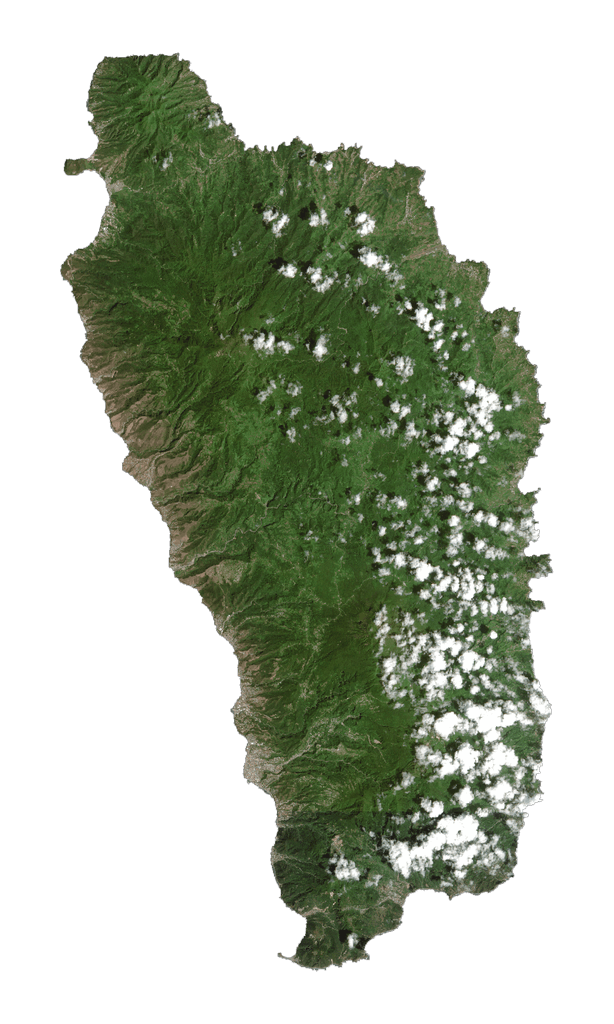The island nation of Dominica in the Caribbean Sea, is volcanic in origin. It has a total area of 750 sq. km (290 sq mi).
As observed on the physical map of Dominica, the terrain is mostly mountainous. The landscape is also almost totally covered by rainforest. Across the island, north to south and east to west, volcanic slopes and gorges dominate the landscape.
The highest peak is Morne Diablatins at 1,447m (4,747 ft). A yellow triangle marks its position on the map.
Nine of the Caribbean’s 16 active volcanoes are located on the island of Dominica. One of these is Morne aux Diables at 848m (2,826 ft), an isolated cone that forms a peninsula at the extreme northern end of the island.
Further south, Morne Trois Pitons National Park is home to three volcanic peaks. The Park’s “Valley of Desolation” is an area of boiling mud ponds and small geysers. Located there, the Boiling Lake is the world’s second largest hot spring.
According to the historical records Dominica is among the Earth’s most rain-drenched lands, and that water runs off forms hundreds of streams, dozens of rivers and a handful of small crater lakes.
Explore the lush beauty of Dominica with this interactive map. See populated places, highways, and airports, as well as an elevation and satellite view. Experience the “Nature Island of the Caribbean” for yourself!
Online Interactive Political Map
Click on ![]() to view map in "full screen" mode.
to view map in "full screen" mode.
Dominica (officially, the Commonwealth of Dominica) is divided into 10 parishes. In alphabetical order, the parishes are: Saint Andrew, Saint David, Saint George, Saint John, Saint Joseph, Saint Luke, Saint Mark, Saint Patrick, Saint Paul and Saint Peter.
Located on the south western coast of the island country at the mouth of River Roseau is, Roseau – the capital, the largest and the most populous city of Dominica. It is an important port, administrative, commercial, and economic center of the country.
Location Maps
Where is Dominica?
Dominica is a small island nation located in the Caribbean, near Guadeloupe and Montserrat to the north, and Martinique and Saint Lucia to the south. With an area of 750 square kilometers, it is comparable in size to Singapore. The island’s coastline of 148 km (92 mi) could be driven around in a little over an hour. Roseau is Dominica’s capital and largest city, with a population of about 15,000 people. The total population of the country is 72,000, and English is its official language.
High Definition Political Map of Dominica

History
Geologic history
Dominica first emerged from the sea during the Oligocene era approximately 26 million years ago, making it one of the last Caribbean islands to be formed by volcanic activity.
Pre-colonial period and early European contact
Dominica’s precolonial indigenous inhabitants were the Island Carib people, who are thought to have driven out the previous Arawak population. The Caribs called the island Wai‘tu kubuli, which means “Tall is her body.”
Christopher Columbus, sailing for Spain, named the island as Dominica, after the Latin term dies Dominica for Sunday, the day on which the Spanish first saw it in November 1493. Some Spanish colonisers settled here. But, as European explorers and settlers entered the region, indigenous refugees from surrounding islands settled Dominica and pushed out the Spanish settlers. The Spanish instead settled other areas that were easier to control.
French colony
Spain had little success in colonising Dominica. In 1632, the French Compagnie des Îles de l’Amérique claimed it and other “Petites Antilles” for France, but no physical occupation took place. Between 1642 and 1650, French missionary Raymond Breton became the first regular European visitor to the island.
In 1660, the French and English agreed that Dominica and St. Vincent should not be settled, but instead left to the Carib as neutral territory—but its natural resources attracted expeditions of English and French foresters, who began harvesting timber. In 1690, the French established their first permanent settlements. French woodcutters from Martinique and Guadeloupe began to set up timber camps to supply the French islands with wood, and they gradually became permanent settlers. They brought the first enslaved Africans from West Africa to Dominique, as they called it in French.
In 1715, a revolt of “poor white” smallholders in the north of Martinique, known as La Gaoulé, caused settlers to migrate to southern Dominique, where they set up smallholdings. Meanwhile, French families and others from Guadeloupe settled in the north. In 1727, the first French commander, M. Le Grand, took charge of the island with a basic French government. Dominique formally became a colony of France, and the island was divided into districts or “quarters”. The French had already developed plantation agriculture on Martinique and Guadeloupe, where they cultivated sugarcane with enslaved African workers. In Dominique they gradually developed coffee plantations. Because of the trans-Atlantic slave trade, the general population came to consist primarily of black-African slaves.
In 1761, during the Seven Years’ War in Europe, a British expedition against Dominica led by Andrew Rollo conquered the island, along with several other Caribbean islands. In 1763, France had lost the war and ceded the island to Great Britain under the Treaty of Paris. The same year, the British established a legislative assembly, with only European colonists represented. French remained the official language, but Antillean Creole, which had developed from it, was spoken by most of the population.
In 1778 the French, with the active co-operation of the population, began the re-capture of Dominica. This was ended by the Treaty of Paris (1783), which returned the island to British control. But the island population, especially the class of free people of color, resisted British restrictions. The British retained control throughout French invasions in 1795 and 1805, the first taking place during the period of the Haitian Revolution, which gained the independence of Haiti (formerly Saint-Domingue, France’s richest Caribbean colony).
British colony
Great Britain established a small colony in 1805. It used Dominica as part of the Trans-Atlantic Slave Trade, by which slaves were imported and sold as labour in the islands as part of a trade that included producing and shipping sugar and coffee as commodity crops to Europe. The best documented slave plantation on the island is Hillsborough Estate, which had 71 male and 68 female slaves. The Greg family were notable: Thomas Hodgson, a brother-in-law, owned a slave ship, and Thomas Greg and his son John Greg were part-owners of sugar plantations on Dominica. In January 1814, 20 slaves absconded from Hillsborough. They were recorded as recaptured and punished with 100 lashes applied to the males and 50 for the females. The slaves reportedly said that one of their people had died in the plantation hospital, and they believed he had been poisoned.
In 1831, reflecting a liberalisation of official British racial attitudes, the Brown Privilege Bill conferred political and social rights on free blacks (mostly free people of colour, who generally were of mixed race, with African and European ancestry). With the Slavery Abolition Act of 1833, Britain ended the institution of slavery throughout its empire, except in India.
With freedom came enfranchisement. In 1835, the first three men of African descent were elected to the legislative assembly of Dominica. Many slaves from the neighbouring French colonial islands of Guadeloupe and Martinique fled to Dominica. In 1838, Dominica became the first colony of the British West Indies to have an elected legislature controlled by an ethnic African majority. Most of these legislators had been free people of colour and smallholders or merchants before the abolition of slavery. Their economic and social views were different from the interests of the small, wealthy English planter class. Reacting to a perceived threat to their power, the planters lobbied for more direct British rule.
In 1865, after much agitation and tension, the colonial office replaced the elective assembly with one made up of one-half members who were elected and one-half who were appointed. Planters, who were allied with colonial administrators, outmanoeuvred the elected legislators on many occasions. In 1871, Dominica became part of the British Leeward Islands. The political power of the elected assembly progressively eroded. Crown colony government was re-established in 1896.
Early 20th century
In World War I, many Dominicans, mainly the sons of small farmers, volunteered to fight in Europe for the British Empire. After the war, an upsurge of political consciousness throughout the Caribbean led to the formation of the Representative Government Association. Marshaling public frustration with the lack of a voice in governing Dominica, this group won one-third of the popularly elected seats of the legislative assembly in 1924, and one-half in 1936. In 1940, administration of Dominica was transferred from the British Leeward Islands to the British Windward Islands. During World War II, some Dominicans volunteered in British and Caribbean forces. Thousands of Free French refugees from Martinique and Guadeloupe escaped to Dominica from the Vichy-controlled French islands, staying in Roseau and other villages.
Until 1958, Dominica was governed as part of the British Windward Islands. Caribbean islands sought independence from 1958 to 1962, and Dominica became a province of the short-lived West Indies Federation in 1958. After the federation dissolved in 1962, Dominica became an associated state of the United Kingdom in 1967, and formally took responsibility for its internal affairs. On 3 November 1978, the Commonwealth of Dominica was granted independence as a republic, led by Prime Minister Patrick John.
Post-independence
In mid-1979, political discontent with Founding Prime Minister Patrick John’s administration climaxed in a civilian coup and ended in the passage of a Motion of No Confidence in the House of Assembly, Dominica’s legislature, against John, collapsing the John administration. A new, so-called “Interim Government” was formed under Dominica’s second Prime Minister Oliver Seraphin; Seraphin’s main task was to prepare the country for fresh general elections constitutionally due in 1980, hence the unofficial title “Interim” Prime Minister. Seraphin organized and led a splinter of the Dominica Labour Party called the Democratic Labour Party into the 1980 general election and lost mainly because his nearly 13 month-long premiership was dominated by the fallout from Category Five Hurricane David, which caused 56 deaths and untold damage across the island. Hurricane Allen the following year caused further damage. After the 1980 election, Seraphin’s government was replaced by one led by the Dominica Freedom Party (DFP) under Prime Minister Eugenia Charles; she was the Caribbean’s first female Prime Minister.
In 1981, Charles’s government was threatened with two attempted coups. The first was led by Frederick Newton, commander of the Military of Dominica, who organised an attack on the police headquarters in Roseau which resulted in the death of a police officer. Newton and five other soldiers were found guilty in the attack and sentenced to death in 1983; the sentences of the five accomplices were later commuted to life in prison, but Newton was executed in 1986. A second occurred later in the year when the country was threatened with a takeover by mercenaries in Operation Red Dog, led by Mike Perdue and Wolfgang Droege. They tried to overthrow Charles as Prime Minister and reinstall ex-Prime Minister John in exchange for control over the country’s development. The FBI was tipped off, and the ship hired to transport the mercenaries never left dock. The mercenaries lacked formal military experience or training, and most of the crew had been misled into joining by the ringleader Mike Perdue. White supremacist Don Black was also jailed for his part in the attempted coup, which violated US neutrality laws.
The Charles government supported the 1983 American invasion of Grenada, earning Dominica praise from the U.S. government of Ronald Reagan, and an increase in financial aid.
By the middle of the 1980s, the economy had begun to recover, before weakening again due to a decrease in banana prices. Eugenia Charles won the 1985 general election, becoming only the first incumbent Dominica Prime Minister to be popularly re-elected. The continuing downturn in the economy and the tight grip by Eugenia Charles on Dominica politics gave rise to a self-titled “Third Force” political formation in 1988, which disrupted the traditional two-party arrangement of governing DFP and opposition DLP. “Third Force” soon formalized as United Workers Party and selected as its leader Edison James, the former General Manager of the Dominica Banana Marketing Company. This was a strategic selection given James’s prestige among banana farmers and his originating from the East or Atlantic Coast that had begun to feel alienated by the West or Caribbean Sea Coast elites in Roseau, Dominica’s capital. Eugenia Charles again won the 1990 general election, the first incumbent Dominica Prime Minister to win three consecutive general elections. However, Eugenia Charles’s DFP had been pushed to within one seat of losing its majority in Parliament by the emergence of the UWP. It was, therefore, no great surprise when Eugenia Charles gave up political leadership of the Dominica Freedom Party in 1993 and did not contest the 1995 general election in any capacity. No longer benefiting from the veteran charismatic leadership of Prime Minister Eugenia Charles, the Dominica Freedom Party lost the 1995 election to the United Workers’ Party (UWP), whose leader Edison James became Prime Minister. James, former General Manager of the Dominica Banana Marketing Company attempted to diversify the Dominican economy away from over-reliance on bananas. The crop was largely destroyed by Hurricane Luis in 1995. Further James was unable to restore banana to its former selling price and prestige. Moreover, the James administration became embroiled in Opposition charges of official corruption.
In the 31 January 2000 general election, the UWP were defeated by a coalition of the DLP, led by left-leaning Roosevelt B. “Rosie” Douglas and the Dominica Freedom Party led by former trade union leader, Charles Savarin. Douglas became Prime Minister. One UWP member of the House of Assembly crossed the floor, joining the DLP-DFP coalition government. However, Douglas died on 1 October 2000 after only a few months. Prime Minister Douglas was replaced by Pierre Charles, who also died in office on 6 January 2004. Roosevelt Skerrit, also of the DLP, replaced Pierre Charles as Prime Minister, becoming the world’s youngest head of government at the age of 31. Under Skerrit’s leadership, the DLP won elections in May 2005 that gave the party 12 seats in the 21-seat Parliament, to the UWP’s 8 seats. An independent candidate affiliated with the DLP won a seat as well. Later, the independent candidate joined the government. With his 2005 election win, Skerrit became only the second incumbent Prime Minister of seven to be popularly re-elected.
In the 2009 election, the DLP won 18 of 21 seats. The UWP claimed campaign improprieties and embarked on a wide range of protest actions, including boycott of Parliament. UWP’s boycott lasted at least three unauthorized absences from Parliament for two of their three Elected Representatives in Parliament in violation of Parliamentary procedure, leading to their two seats being declared vacant and by-elections being called to fill them; by-elections were conducted for those two vacant seats in July 2010, and the UWP again won both seats. The DLP under Skerrit went on to win the 2014 Dominican general election.
On 17 September 2012 Eliud Thaddeus Williams was sworn in as President (a largely ceremonial role), replacing Dr. Nicholas Liverpool who was reportedly removed from office due to ill health. On 30 September 2013 former Trade Union leader and former Dominica Freedom Party leader Charles Savarin was elected president having only days before resigned as a Minister of Government. He is Dominica’s eighth President.
Tropical Storm Erika devastated the island in August 2015, killing 30 and causing severe environmental and economic damage. Dominica was again struck on 18 September 2017, suffering a direct landfall from Category 5 Hurricane Maria. Early estimates of damage suggested 90% of the buildings on the island had been destroyed, with infrastructure left in ruins. The UK, France and the Netherlands set up shipping and air lifts to take aid to the island; the scale of destruction having left most people homeless.
Dominica won its first two Commonwealth Games medals in silver and bronze in the 2018 Commonwealth Games on the Gold Coast.
President Charles Angelo Savarin was re-elected in 2018 for a new five-year term.
In December 2019, incumbent Prime Minister Roosevelt Skerrit won his fourth consecutive general election eighteen seats to three, becoming the first Dominica Prime Minister ever to do so.
Physical Map of Dominica
